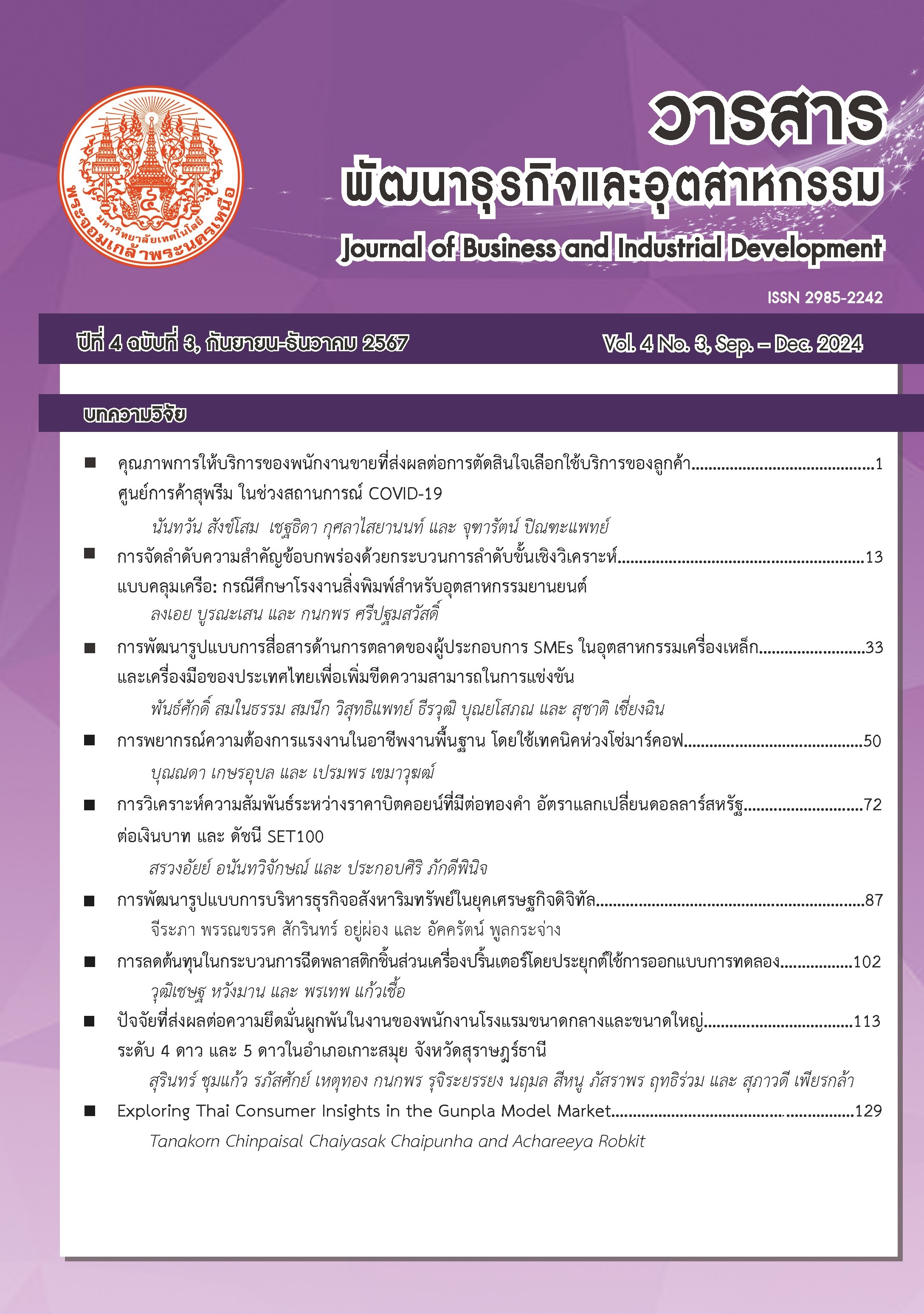Analysis of the relationship Between Bitcoin that affects Gold, US Dollars to Thai Baht Exchange Rate and SET100 Index
Keywords:
Analysis of The Relationship, Bitcoin, Gold, US Dollars to Thai Baht Exchange, SET100Abstract
The objectives of this study are 1) to check the consistency of the model with empirical data and 2) to study the relationship Between Bitcoin that affects Gold, US Dollars to Thai Baht Exchange Rate, and SET100 Index. This research employs a quantitative approach to analyze the relationship between Bitcoin and Gold. Analyze with a linear relationship, using the AMOS program for the analysis of the US Dollar to Thai Baht Exchange Rate and SET100 Index, whether it is consistent and harmonious with the empirical data or not, and using daily secondary data for 5 years from 3 January 2018 to 30 December 2022 from the website Investing.com. The findings indicate that: 1) Bitcoin has a positive relationship with Gold (TE = 0.64) and a positive relationship with the US Dollar to Thai Baht exchange rate (TE = 0.16). In contrast, Bitcoin shows a negative relationship with the SET100 index, supported by the statistical analysis, which yielded a Chi-square value of 3.803, degrees of freedom (df) = 2, P = 0.149, CMIN/DF = 1.901, GFI = 0.998, and RMSEA = 0.027. These results are consistent with the assumption of statistical significance at the 0.001 level. 2) Additionally, the analysis reveals that Bitcoin weighs 0.64, which affects Gold, allowing for a variance prediction with an accuracy of 41% (R² = 0.41). Bitcoin weights 0.16 affects the US Dollar to Thai Baht exchange rate, which predicts the variance with an accuracy of 3% (R² = 0.03). Finally, Bitcoin weights -0.20 affects the SET100 index, predicting variance with an accuracy of 4% (R² = 0.04).
References
Nian, L. P., & Chuen, D. L. K. (2015). Introduction to Bitcoin. In Handbook of Digital Currency (pp. 5–30). Academic Press.
Ferreira, A., & Sandner, P. (2021). Eu Search for Regulatory Answers to Crypto Assets and Their Place in the Financial Markets’ Infrastructure. Computer Law & Security Review, 43, 105632. https://doi.org/10.1016/j.clsr.2021.105632
Koumba, U., Mudzingiri, C., & Mba, J. (2020). Does Uncertainty Predict Cryptocurrency Returns? A Copula-Based Approach. Macroeconomics and Finance in Emerging Market Economies, 13(1), 67–88. https://doi.org/10.1080/17520843.2019.1650090
Al-Yahyaee, K. H., Mensi, W., Al-Jarrah, I. M. W., Hamdi, A., & Kang, S. H. (2019). Volatility Forecasting, Downside Risk, and Diversification Benefits of Bitcoin and Oil and International Commodity Markets: A Comparative Analysis with Yellow Metal. The North American Journal of Economics and Finance, 49, 104–120. https://doi.org/10.1016/j.najef.2019.04.001
Bouri, E., Shahzad, S. J. H., Roubaud, D., Kristoufek, L., & Lucey, B. (2020). Bitcoin, Gold, and Commodities as Safe Havens for Stocks: New Insight Through Wavelet Analysis. The Quarterly Review of Economics and Finance, 77, 156–164. https://doi.org/10.1016/j.qref.2020.03.004
Glaser, F., Zimmermann, K., Haferkorn, M., Weber, M. C., & Siering, M. (2014). Bitcoin-Asset or Currency? Revealing Users' Hidden Intentions. Revealing Users' Hidden Intentions (April 15, 2014). ECIS.
Klein, T., Thu, H. P., & Walther, T. (2018). Bitcoin Is Not the New Gold–A Comparison of Volatility, Correlation, and Portfolio Performance. International Review of Financial Analysis, 59, 105–116. https://doi.org/10.1016/j.irfa.2018.07.010
Basher, S. A., & Sadorsky, P. (2022). Forecasting Bitcoin Price Direction with Random Forests: How Important Are Interest Rates, Inflation, and Market Volatility?. Machine Learning with Applications, 9, 100355. https://doi.org/10.1016/j.mlwa.2022.100355
Rehman, M. U., & Vo, X. V. (2020). Cryptocurrencies and Precious Metals: A Closer Look from Diversification Perspective. Resources Policy, 66, 101652. https://doi.org/10.1016/j.resourpol.2020.101652
Hayes, A. S. (2017). Cryptocurrency Value Formation: An Empirical Study Leading to a Cost of Production Model for Valuing Bitcoin. Telematics and Informatics, 34, 1308–132. https://doi.org/10.1016/j.tele.2016.05.005
Manaserh, A. A. S. (2020). A Relationship Between Bitcoin and Foreign Exchange Rates: A Quantitative Research on Bitcoin, and Selected Foreign Exchanges. Yayımlanmamış Yüksek Lisans Tezi). İstanbul Aydın Üniversitesi, İstanbul.
Baur, D. G., Dimpfl, T., & Kuck, K. (2018). Bitcoin, Gold and the US Dollar–A Replication and Extension. Finance Research Letters, 25, 103–110. https://doi.org/10.1016/j.frl.2017.10.012
Dyhrberg, A. H. (2016). Hedging Capabilities of Bitcoin. Is It the Virtual Gold?. Finance Research Letters, 16, 139–144. https://doi.org/10.1016/j.frl.2015.10.025
Sirinaovakul, W., & Teerakapibal, S. (2021). The Relationship Between Bitcoin and Gold (No. 190946). Thammasat University. (in Thai)
Oad Rajput, S. K., Soomro, I. A., & Soomro, N. A. (2022). Bitcoin Sentiment Index, Bitcoin Performance and US Dollar Exchange Rate. Journal of Behavioral Finance, 23(2), 150-165. https://doi.org/10.1080/15427560.2020.1864735
Hair, J. F. (Jr.), Hult, G. T. M., Ringle, C. M., & Sarstedt, M. (2014). A Primer on Partial Least Squares Structural Equation Modeling (PLS-SEM). California, CA: Sage Publications. https://doi.org/10.1007/978-3-030-80519-7
Afthanorhan, W. M. A. B. W. (2013). A Comparison of Partial Least Square Structural Equation Modeling (PLS-SEM) and Covariance Based Structural Equation Modeling (CB-SEM) for Confirmatory Factor Analysis. International Journal of Engineering Science and Innovative Technology, 2(5), 198–205.
Prukumpai, S., & Sethapramote, Y. (2023). Are Bitcoin and Gold Safe Haven Assets? Evidence from Thailand. Kasetsart Journal of Social Sciences, 44(2), 419-428. Retrieved from https://so04.tci-thaijo.org/index.php/kjss/article/view/266268 (in Thai).
Arwatchanakarn, P., Kuendee, H., & Srijunngam, J. (2022, March). The Effects of Global Investment Assets on the Thai Stock Market. In 2022 International Conference on Decision Aid Sciences and Applications (DASA) (pp. 1219–1223). IEEE.
Sakulchaikaew, T., & Siwasarit, W. (2022). The Dynamic Correlation Between Cryptocurrency and Thai Financial Assets with the Impact of Global Macro-Level Variables [Unpublished master's thesis]. Thammasat University.
Downloads
Published
How to Cite
Issue
Section
License
Copyright (c) 2024 Journal of Business and Industrial Development

This work is licensed under a Creative Commons Attribution-NonCommercial-NoDerivatives 4.0 International License.




